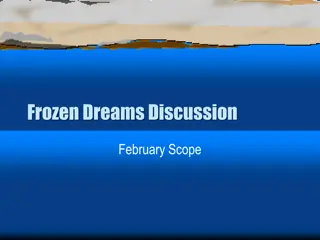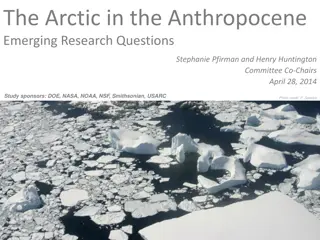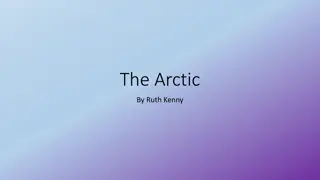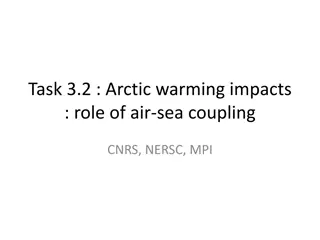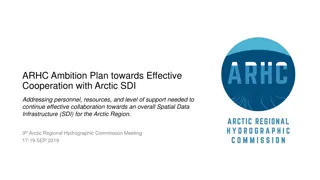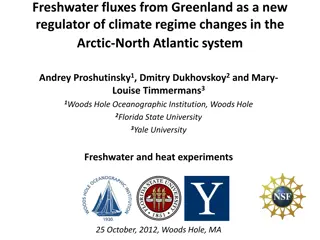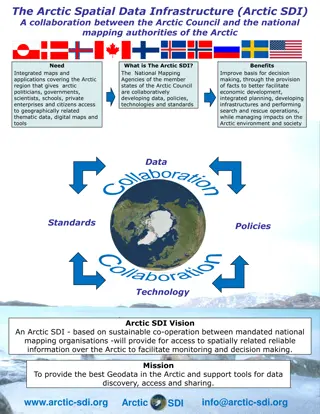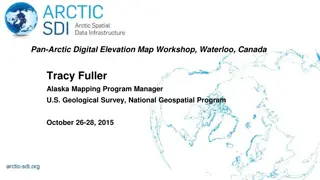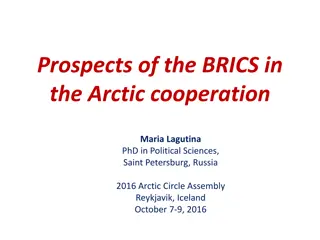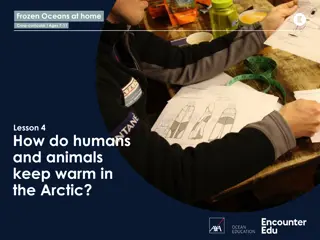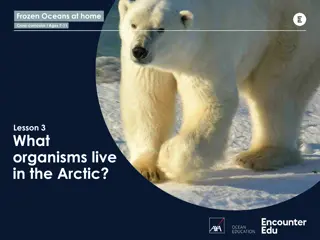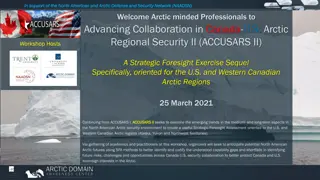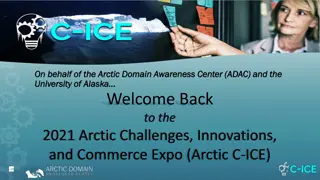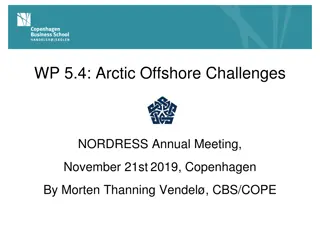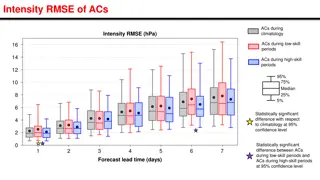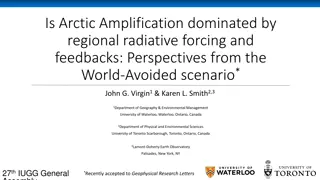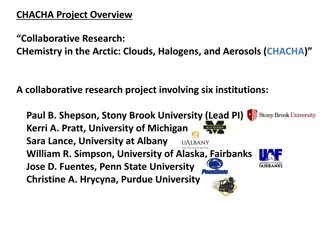Exploring the GEOTRACES Arctic Program and Its Scientific Objectives
The GEOTRACES Arctic Program aims to study marine biogeochemical cycles in the Arctic region, focusing on trace elements and isotopes. Through international collaboration, the program identifies processes affecting the distribution of key elements in the ocean. The unique Arctic environment, vulnerable to climate change, plays a crucial role in global systems like climate and carbon transport. Objectives include studying ocean interfaces, internal cycling, micronutrients, freshwater sources, and atmospheric deposition. Understanding these processes is essential for climate research and ocean health.
Download Presentation

Please find below an Image/Link to download the presentation.
The content on the website is provided AS IS for your information and personal use only. It may not be sold, licensed, or shared on other websites without obtaining consent from the author. Download presentation by click this link. If you encounter any issues during the download, it is possible that the publisher has removed the file from their server.
E N D
Presentation Transcript
The GEOTRACES Arctic Program Dave Kadko, University of Miami (25.80N) Bill Landing, Florida State University (30.42N) Greg Cutter, Old Dominion University (36.83N) AOMIP-FAMOS Workshop, WHOI October 2012
ARCTIC GEOTRACES Program Presentation Outline: The Science: what is GEOTRACES, why study the Arctic, what will we measure? Cruise plan discussion within the international framework. Timeline: Where we ve been, where we are, where we re headed! Anticipated Benefits from Arctic GEOTRACES
What is GEOTRACES? An international program designed to study the marine biogeochemical cycles of trace elements and their isotopes. Its Mission is: To identify processes and quantify fluxes that control the distributions of key trace elements and isotopes (TEIs) in the ocean, and to establish the sensitivity of these distributions to changing environmental conditions
Strategy and Overarching Scientific Goals Need to understand and quantify fluxes at ocean interfaces and rates and mechanisms of internal cycling processes.
The Arctic is Unique Extremely vulnerable to climate change. Plays a major role in global climate, thermohaline circulation, planetary heat budget, carbon transport. Only ~ 2% of total ocean volume BUT 10% of the global river run-off is delivered to the Arctic Arctic shelves represent 25% of the global shelf area 30% of the world s soil carbon stored in northern ecosystems Warming climate should increase export of organic carbon to the Arctic Ocean. Sea Ice: Captures and transports atmospheric deposition of TEIs, pollutants, soot. This important geochemical/ecological pathway will change as ice disappears!
Objectives for Arctic GEOTRACES: Fluxes and Processes at Ocean Interfaces Rates and Mechanisms of Internal Cycling Development of Proxies for Paleoceanographic Studies Essential Micronutrients and trace metal cycling Mn, Fe, Co, Ni, Cu, Zn, Cd, other TEIs, REEs, nano-nutrients Tracers of freshwater sources 18O, Ba, Ra isotopes, nutrients, terrestrial DOC Tracers of particle flux 234Th, 230Th, 231Pa, 210Po, 210Pb Tracers for exchange of shelf with open ocean Mn, Fe, Al, REE, 228Ra, Nd, Hf, Be, DOC (lignin) Tracers of water mass circulation and mixing Pu, 137Cs, 129I, 99Tc, 227Ac, 7Be Atmospheric deposition 210Pb, 7Be, Hg, Fe, Al, anthropogenic TEIs (As, Se, Pb, Zn)
Why have an Arctic GEOTRACES Program Now? Establish baselines for TEI distributions and cycling rates in advance of anticipated rapid change in the Arctic (better late than never!) Improved ability to sample the ocean, process and store the samples without contamination Non-metallic (plastic) sampling devices bottles and cables. Sample storage bottles of non-contaminating plastics. Clean acids via sub-boiling distillation for sample preservation. New analytical tools with low detection limits and high precision ASV, TIMS, ICP-MS (sector field, multi-collector) Rates and fluxes can be derived using advanced modeling (e.g. inverse methods).
Accuracy and precision for trace elements is comparable to that for major nutrients Zn (nmol kg-1) Al (nmol kg-1) 0 2 4 6 8 10 0 10 20 30 40 0 0 500 1000 1000 Carousel - Osmonics TITAN - 2010 Carousel - Nuclepore 1500 Depth (m) Depth (m) 2000 2000 2500 3000 3000 3500 4000 UAF Vane Carousel Average 4000
Transport pathways (currents, riverine fluxes, atmospheric deposition) bring contaminants and natural TEIs into the Arctic
Sampling: o Water column (dissolved TEIs, nutrients, hydrography) o Suspended particles o Sea ice + dirty ice ; melt ponds, ice-edge, under ice sampling; ice algae o Aerosols o Precipitation o Surface sediments
SHELF PROCESSES Physical, biogeochemical, and biological fluxes interact; impact on Arctic ecosystems (e.g. heat, fresh water, nutrients, carbon, TEI tracers) Biologically-mediated redox processes are critical to carbon and bioactive TEI cycling and to regional and global carbon flux dynamics (how much, how fast, in what forms, where to?) Macdonald and Gobeil (2011). Nearly quantitative reduction of MnOx(s) on shelf followed by offshore transport.
Sea Ice Impacts ocean chemistry and ecology o Sea-ice receives and transports atmospherically deposited material (e.g. Hg, Pb, As, Se, Cd, Zn, soot, natural aerosols). o Strongly influences gas exchange (e.g. CO2). o Ice-algae: cycle nutrients and bio-active TEIs; serve as a food source for Arctic food webs.
also ....... What about sediment-laden (dirty) Sea Ice >100,000 km2 of sediment-laden sea ice (5-8 x 106 t particulate export) Enhanced rafting due to changing sea- ice regime? Source of TEIs to Arctic interior Impact on ice primary production and carbon flux? Multiple rafting with sediment layers in lower sections Changes in sea-ice coverage/timing will affect the distribution and partitioning of TEIs within the ocean and the nature of important ocean processes: gas-exchange biological productivity sedimentation, removal of contaminants
There are even hydrothermal vents! The ultra-slow spreading Gakkel Ridge. POLARSTERN, 2007 IPY (Rob Middag; Hein de Baar) How do these fluxes impact the Arctic? How will we model these tracer fields?
Planning for an international Arctic GEOTRACES initiative is logistically complex. Four nations (Sweden, Canada, Germany and the U.S.) have active GEOTRACES programs that will pursue the use of a national icebreaker. In addition, GEOTRACES scientists from other nations (e.g., The Netherlands, U.K., France and Spain) are interested in participating. The desired objective is to mount a 4-ship operation in 2015 (US, Canada, Germany, Sweden) to support the collaborative research of investigators from all nations. USCG HEALY and Canadian Coast Guard Cutter LOUIS S. ST. LAURENT working together (2010). GEOTRACES Arctic workshop in Moscow Nov. 26-30, 2012
NOAA/RUSALCA K K US McK McK L L AR T D AR T Y Y Sw O O Russia CA UK
GOALS US Arctic GEOTRACES Bering Strait choke point measure TEIs in conjunction with moored array temperature, salinity, water velocity and transmissivity data (RUSALCA: Univ. Washington, Univ. Alaska, Arctic and Antarctic Res. Inst., Russia---Rebecca Woodgate et al.). --Fluxes of water and TEIs at this major gateway Shelf-Basin exchange Transport and transformations Boundary scavenging processes Deep basin transects: --crossing fronts; Atlantic, Pacific, Transpolar Drift. -- Sea ice: a platform for retaining and transporting TEIs -partitioning of TEIs between different compartments (atmosphere, surface water, snow, ice)
Figure 2. Anticipated track for the US Arctic GEOTRACES cruise in 2015. The outbound, northward leg would be extended if the German expedition does not occur. The number of stations along the deep-basin transects will be adjusted as needed to account for sea and iceconditions.
Timeline: o June 2009: Arctic GEOTRACES workshop in Delmenhorst. o June 2011: NSF-OPP and CO agree to co-fund US Arctic GEOTRACES proposals. o January 2012 -- Ship time request for the Healy (Kadko, Landing, Cutter, Anderson) o June 13-15, 2012 -- Arctic Planning workshop formulate science plan (continued coordination with international partners) NSF HQ. o October 15, 2012 -- Management proposal submitted (Kadko, Landing, Cutter). o Summer 2013 -- Management proposal awarded (?). o Feb 2014 -- PI science proposals. o Winter 2014 -2015. PI cruise-planning meeting. o Aug Sept 2015: Research Cruise. o Fall 2016 (AGU?): Post-cruise data workshop
What are the anticipated benefits? They include: 1) Identify sources and sinks and quantify internal cycling of essential micronutrients and other TEIs (e.g., Mn, Fe, Co, Ni, Cu, Zn, Cd). 2) Calibrate geochemical tracers used to reconstruct past ocean conditions (e.g., circulation, chemistry, biological productivity, carbon fluxes) for more reliable applications. 3) Improve predictions of the cycling and fate of natural and contaminant TEIs. 4) Apply knowledge to predicting trajectory and impacts of change in the Arctic.
www.geotraces.org ipo@geotraces.org


